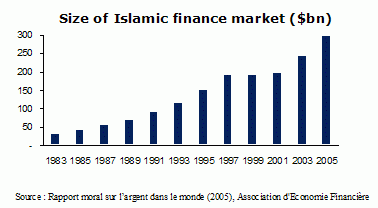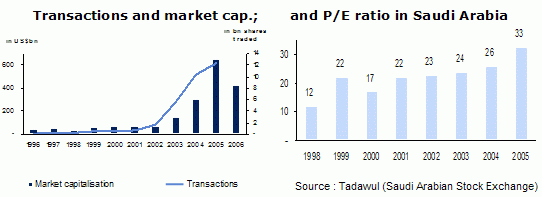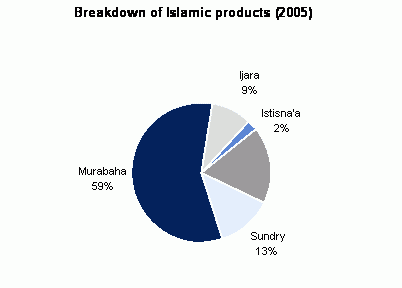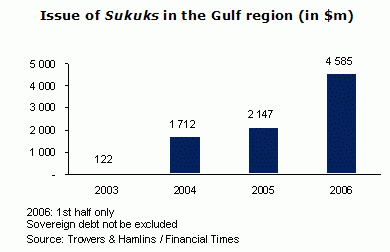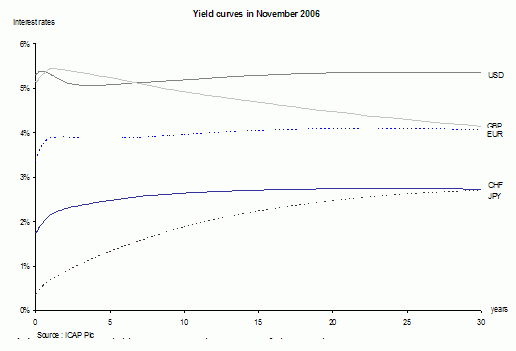Letter number 20 of November 2006
ALL ARTICLES
- TOPIC
- STATISTICS
- RESEARCH
- QUESTIONS & COMMENTS
News : Islamic finance
Contemporary Islamic finance arose in the 1970s in response to the first oil crisis. Today, this type of finance accounts for $300bn. The IMF estimates that at the close of 2005, there were over 300 institutions offering Islamic finance in more than 75 countries, with a growth rate for this sector of 15% per year over the next 10 years.
The Islamic finance market has experienced exceptional growth since 2001. This growth is mainly driven by the repatriation of funds from the Middle East to their country of origin following September 11, 2001, the economic boom and stock market growth recorded in the region, illustrated by the Riyadh stock exchange with a 10-fold increase in market capitalisation and a 2-fold increase in P/E ratios over the last five years.
Conventional banks have reacted swiftly to this situation, keen to grab a share of this manna from heaven and even to win new clients. Many of them have gone as far as to launch their own Islamic subsidiaries.
For example, the share of Islamic products in the banking system of countries in the Gulf Co-operation Council (GCC) accounts for 17% of total assets. These assets themselves only account for 28% of Islamic financial assets worldwide.
The Islamic investment fund market is also one of the sectors of Islamic finance experiencing massive growth. There are currently around 100 Islamic private equity funds in the world. The total assets managed by these funds exceeds $5bn. Even though this amount is increasing at a rapid pace, it is still very little considering that large LBO funds currently raise three times that amount.
The underlying principles of Islamic finance
Sharia law is not opposed to the centuries old principle of earning a return on money that is lent, but rather on the fixed and predetermined nature of the return (Riba). Under Islamic law, the basis of any return on invested money should be the profitability of the asset being financed by the investment. This should be the sole basis for any earnings. As a matter of principle, it excludes the idea of fixed returns that are disconnected from the performance of the asset financed.
In other words, Islamic finance is based on the principle of sharing both losses and profits. The main obligation for a financial transaction is that it must be based on a tangible asset so that the losses and profits generated by this asset can be shared.
In traditional finance, the basis of the interest rate is the fact that a return is earned by foregoing immediate liquidity and accordingly immediate consumption (1). Interest payments are viewed quite differently under Islamic finance.
In theory, this should mean that equity capital rules, because the borrower knows that in the event of problems, debt and earnings will not have the same obligatory character as is usually the case. Fixed financial costs do not exist since in the case of adversity, they become variable costs. There is thus no leverage effect, which should result in fewer companies going bankrupt, and accordingly, will lead to lower ROCE. Because they have not been eliminated by bankruptcy, inefficient players, are able to continue operating (and earning lower margins) for longer, which brings down the ROCE for the whole sector.
On the other hand, the possibility of making a fortune as an entrepreneur would appear to be more limited if there is no access to leverage, which was what enabled Richard Branson, Lakshmi Mittal or Bernard Arnault (LVMH) to become weathly businessmen.
Islam is also against any form of speculation (Gharar) and any betting on a future outcome. Accordingly, all forms of short selling, options, swaps, etc. are forbidden under an Islamic finance system.
In order to ensure that all of the products they offer comply fully with Islam, Islamic banks have set up independent committees called Sharia Boards, which are made up of theologians who specialise in financial law. These boards play an active role in the development and oversight of banking products. They are also responsible for certifying that each product adheres strictly to the principles of Sharia law.
Standard Islamic products
Islamic products include:
• Murabaha (Intermediation)
The issuing financial institution plays a role of sales intermediary, buying goods needed by clients and then selling them on later at a profit. This is similar to securitisation (2) and nominee agreements (3).
•Mudharaba (Sponsorship)
This is an agreement between a financial institution and a company, with the financial institution acting as provider of funds and the company as the manager, for investing in a pre-determined activity or class of assets, which grants each party a share of the earnings which is determined at the time of the investment. The manager does not share in any financial losses which are borne solely by the provider of capital. The manager’s losses are deemed to be the opportunity cost of the manager's workforce which has failed to generate sufficient revenues.
• Musharaka (Partnership)
This is a partnership between a financial institution and a company under which both the financial institution and the company invest in the project. The financial institution and its partner share the profits and the losses on the basis of pre-agreed ratios. This is very similar to the way industrial and financial players pool their resources in order to launch new ventures.
There is a second type of Musharaka known as diminishing Musharaka under which the company agrees to buy back the share of the financial institution after a given period. This is very similar to a nominee arrangement.
• Ijara (Capital leasing)
This is a leasing agreement whereby a financial institution buys property or capital goods and leases them back to a company.
Ijara can take the form of an Ijara-wa-Iqtina (a leasing agreement with a promise to buy). This is similar to Ijara but includes a promise on the part of the client to buy the asset when the agreement terminates.
Finally, a third form of Ijara is an Ijara with diminishing Musharaka. This contract can be used for the purchase of real estate. The financial institute’s share in the rented asset diminishes with each payment of capital made by the client that exceeds the amount of the rent, with the final goal being the transfer of the property to the client.
•Wakala (Agency)
This is an agency contract which generally includes expert’s fees. Banks often use Wakala for large deposit accounts. The client has invested capital, it appoints an Islamic bank as its agent and pays an expert’s fee to the bank for managing the fund.
• Salam (Forward selling)
This is a short-term agreement under which a financial institution pays, in advance, amounts corresponding to the future delivery of a defined quantity of goods. A Salam is mainly used for financing goods. It is similar to forward selling (4) where delivery is at a future date in exchange for cash payment.
• Istisna’a (Contracting agreement)
This is an agreement under which one of the parties (Moustasni’i) requests the other party (Snai’i) to manufacture or build an asset which is paid for in advance, in instalments or on completion. This is a variation which is similar to the Salam contract, except that the object of the transaction is the delivery of finished products that have undergone a transformation process, and not goods purchased as is.
Istisna’a thus provides medium-term financing to cover financing requirements for the manufacture, construction or supply of finished products.
It is obvious that the Islamic financial products that most closely resemble traditional banking products (Ijara – capital leasing, Murabaha – nominee agreements, securitisation) are the most commonly used (68% in 2005) and that the products that financial institutions find the most risky (Mudharaba - sponsorship, Musharaka – partnership) account for a much smaller share (17% en 2005).
The dream (or the nightmare!) evoked above of a world made up only of equity capital is thus far from becoming a reality. It is true that there is no such thing as a miracle in finance.
Other Islamic financial products
In Islamic finance, current accounts and savings accounts do not earn interest. These deposits are considered as loans (Qard) and their repayment is guaranteed. According to the principle of trust (al-wadiah), the agreement linking the bank with its clients in terms of a current account or a savings account is a contract draw up to protect the wealth of savers.
Returns on investment accounts, used to finance investments, depend on the performance of the investments. Accordingly, the saver could lose all or part of the initial amount.
Islamic bond products are represented by Sukuks. The Sukuk is to Islamic finance what Asset Backed Securities (ABS) are to conventional finance. It has a maturity that is determined in advance and is backed by an asset which makes it possible for the investment to earn a return without the payment of interest. Unsurprisingly, Sukuks are structured in such a way that their holders run a credit risk and receive part of the profit and not a fixed interest payment in advance, like for an ABS.
The products underlying Sukuks could be represented by contracts such as the Ijara, Musharaka or the Mudharaba.
The Saudi Arabian financial group, Dallah Albaraka, issued the first Sukuk in 1998. The Sukuk market will soon be worth more than $10bn.
Islamic financial products have also adapted to meet the requirements of savers and financial institutions, and are following the evolution of modern finance with the development of financial engineering and the appearance of structured products.
Hedging usually relies on options, which are prohibited under Sharia law. Complex arrangements and major structuring efforts thus have to be made in order to hedge against risks and stay within the boundaries of Sharia law. Islamic hedging products are still in their infancy.
As risk aversion or appetite for risk are character traits that are the least equally shared, growth potential for these products is high!
* * *
From a specialised niche, Islamic finance has grown rapidly over the last three decades to become a worldwide industry worth several billion dollars.
Islamic financial institutions would appear to be assured of substantial growth over the coming years, partly driven by the economic patriotism of Arabs and Muslims which will lead to greater migration to Islamic finance. There is no doubt that financial institutions will continue to adapt their products in order to capitalise on the liquidity in Islamic countries today.
Written by Mehdi Sethom and Younès Molato
(1) For more information, see chapter 1 of the Vernimmen.
(2) For more information, see chapter 47 of the Vernimmen.
(3) For more information, see chapter 41 of the Vernimmen.
(4) For more information, see chapter 48 of the Vernimmen.
(2) For more information, see chapter 47 of the Vernimmen.
(3) For more information, see chapter 41 of the Vernimmen.
(4) For more information, see chapter 48 of the Vernimmen.
Statistics : Yield curves
Current yield curves (1) are very interesting, at least for students, as all possible configuration can be observed at the same time:
• a flat curve for $ or € rates;
• a downward sloping curve for £ rates where short term interest rates are relatively high in order to fight inflation or fears of inflations and long-term rates are low as pension funds are scrambling to find long-term fixed income products to fund their obligations;
• an upward sloping curve for yen rates, which is the usually form for a yield curve. The surprise in that we need to go to Japan to find this after so many years during which the Japanese economy was an exception in itself: deflation, interest rates below 0.5%, decreasing stock prices since 1990!
(1) For more on yield curves, see chapter 24 of the Vernimmen
Research : IPO theory and practice
Two researchers from Brigham Young University have made an original contribution to the literature on IPOs (1) by surveying over 300 chief financial officers CFOs of US firms on their behaviour when taking a company public (2).
They look at motivation, timing, underwriter selection and pricing for the issue.
1. Motivation
Historically, two families of theory have developed to explain why firms go public.
The first relies on financial reasoning. The firm is carrying too much debt or its debt is costing it too much to enable it to finance new projects. Listing will it easier for it to make acquisitions and for its founders to diversify their assets.
The second theory is based on marketing and information. Analysts are more interested in listed companies and listing also enhances the reputation of the firm, making it more easily recognisable by clients.
The CFOs surveyed identify the creation of public shares to be used for future acquisitions as the most important motivation for going public. Capital structure explanations (in particular the cost of debt) are not among the most frequently cited.
2. Timing
There is generally strong activity on the primary market when markets are up. The main explanation behind the timing of an IPO is that management is keen to take advantage of market opportunities. The CFOs surveyed confirm this theory.
3. Underwriter selection
The main criteria when selecting an underwriter is the institution’s reputation (considered as very important by over 90% of the CFOs surveyed). This reinforces theories crediting the underwriter with a role in reducing information asymmetry, based on investors’ lack of knowledge of the firm going public being set off by their trust in the underwriter.
On the other hand, the bank’s client base, and other related services that it is able to offer the firm, are of secondary importance.
4. Pricing
The reasons for underpricing of IPOs remain unclear and there are a lot theories that seek to explain it. CFOs acknowledge that IPOs are underpriced by an average of around 10%, which is what explains the good performance of the stock on the first day of trading.
Most of them consider that this is fair compensation for the risk taken by investors when investing in the IPO, which is in line with the theory of information asymmetry. CFOs indicate that the second-most important reason for underpricing is the desire of underwriters to obtain the favour of institutional investors.
Other researchers have suggested that the purpose of underpricing is to replace marketing costs for the IPO, although fewer than 10% of CFOs support this thesis.
(1) For more on IPO, see chapter 41 of the Vernimmen.
(2) J.C. Brau et S.E. Fawcett, Initial Public Offerings : An Analysis of Theory and Practice, Journal of Finance, vol.61,n°1, 2006.
(2) J.C. Brau et S.E. Fawcett, Initial Public Offerings : An Analysis of Theory and Practice, Journal of Finance, vol.61,n°1, 2006.
Q&A : What is staple financing?
Staple financing gets its name from the fact that it is attached or “stapled” to the agreement behind an M&A deal. When a company is sold, (1) a bank offers to provide any buyer that may be interested with financing to cover part of the acquisition. This means that from the outset, the potential buyer is aware of the terms and conditions (amount, interest rate, term, repayment schedule, covenants, documentation, etc.) of a possible bank financing.
Within a very short period, staple financing has become widespread and is used in around half of all M&A transactions, especially in deals between LBO funds for secondary and tertiary LBOs.
The seller appreciates the reassurance brought by staple financing that an agreement signed with a buyer will not fall through because the latter is unable to arrange the necessary financing. The seller may also be hoping that an offer of financing at the start of the process will increase the number of potential buyers, and accordingly, the price obtained will be higher. Additionally, staple financing helps speed up the sale process and thus minimise the risk of leaks, even though leaks are part and parcel of a bidding process, especially when investment funds are involved. In transactions between LBO funds, staple financing is part of the standard package from the outset, along with vendor due diligence (2) and the SPA (sale and purchase agreement), which means that the whole transaction can be completed within a month.
For the buyer, staple financing provides a sure source of some of the financing needed, which helps speed things up, and in a best case scenario, can be used in negotiations with other potential lenders in order to obtain better terms. Staple financing is not generally imposed on the buyer, but is merely an option that can be taken up or not. In some cases, we’ve seen the bank offering the staple financing negotiating with the seller to obtain a right to a share in the financing that will be arranged with competing banks if the staple financing it is offering is not taken up. This does complicate final negotiations somewhat, as the seller then has to ask the buyer to make space in the acquisition loan for the bank offering the staple financing. Which just goes to show that the banks offering this type of financing can never be sure that they’re always going to come out on top!
The bank advising the seller is not necessarily the bank offering the staple financing. Firstly, because all banks are not necessarily involved in both advisory and lending activities, and secondly because both the seller and its advising bank would be set on obtaining the best possible terms for the staple financing in order to maximise the sale price.
When the same bank plays both roles, there is the risk of a conflict of interest. The advisor to the seller will have the buyer as its client (as a borrower) on the same deal For its part, the buyer may be inclined to accept the staple financing in the hope that this will create a favourable impression with the seller. As banks usually earn higher fees for arranging financings (paid by the buyer) than on M&A advisory mandates (paid by the seller), the seller may fear that its advisor could be pushing it to accept the offer of a buyer that has taken up the staple financing, rather than the offer that is in the seller's best interests.
(1) For an explanation on the techniques involved in selling a company see chapter 42 of the Vernimmen.
(2) See the Vernimmen.com Newsletter for september 2006.
(2) See the Vernimmen.com Newsletter for september 2006.
